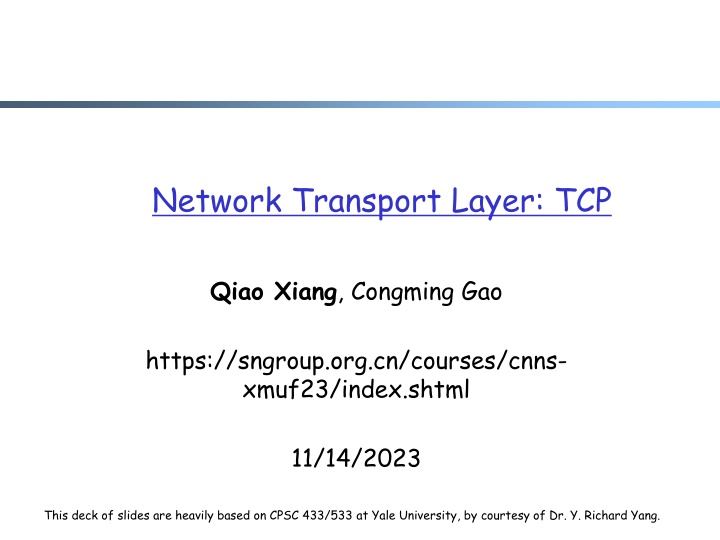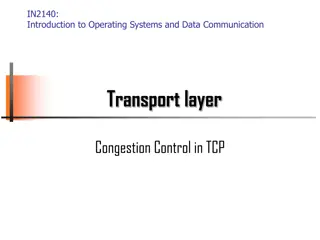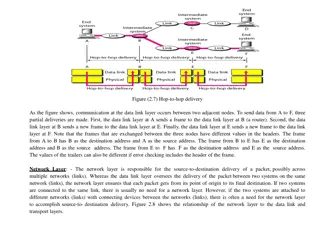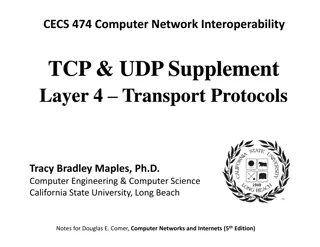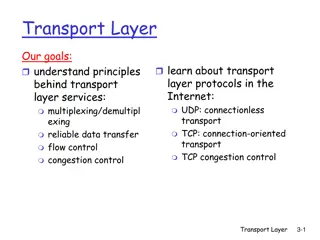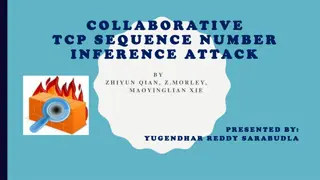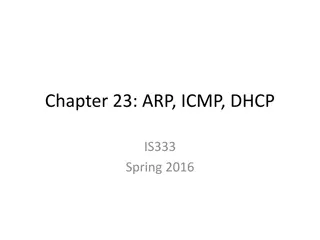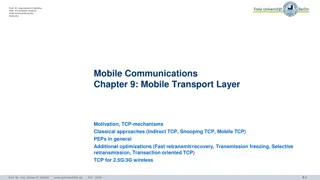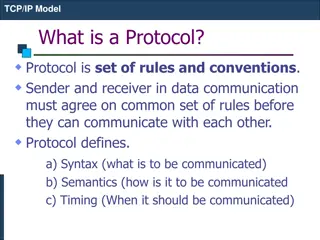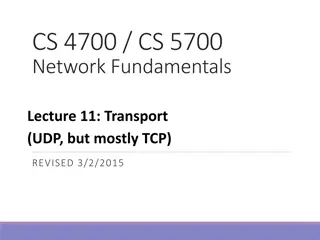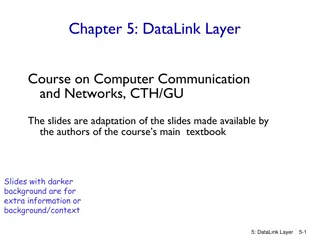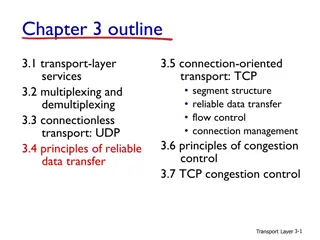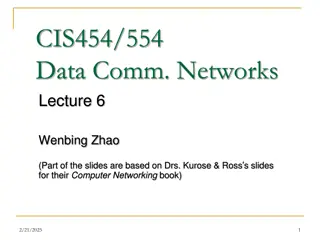Network Transport Layer: TCP Recap and Admin Overview
This deck of slides covers the foundational concepts of TCP reliability, reliable data transfer, sliding window protocols like GBN, SR, and more. It delves into the structure of TCP segments, connection-oriented aspects, and the combination of go-back-n and selective repeat methods. Learn about sliding window protocols, buffer sizes, and the complexities of reliable transport in computer networks.
Download Presentation

Please find below an Image/Link to download the presentation.
The content on the website is provided AS IS for your information and personal use only. It may not be sold, licensed, or shared on other websites without obtaining consent from the author.If you encounter any issues during the download, it is possible that the publisher has removed the file from their server.
You are allowed to download the files provided on this website for personal or commercial use, subject to the condition that they are used lawfully. All files are the property of their respective owners.
The content on the website is provided AS IS for your information and personal use only. It may not be sold, licensed, or shared on other websites without obtaining consent from the author.
E N D
Presentation Transcript
Network Transport Layer: TCP Qiao Xiang, Congming Gao https://sngroup.org.cn/courses/cnns- xmuf23/index.shtml 11/14/2023 This deck of slides are heavily based on CPSC 433/533 at Yale University, by courtesy of Dr. Y. Richard Yang.
Outline Admin and recap TCP Reliability 2
Admin Lab 3 due on Nov. 19 Lab 4 to be posted this week 3
Recap: Reliable Data Transfer Context rdt_send():called from above, (e.g., by app.) deliver_data():called by rdt to deliver data to upper send side receive side udt_send():called by rdt, to transfer packet over unreliable channel to receiver rdt_rcv():called from below; when packet arrives on rcv-side of channel 4
Recap: Reliable Transport Basic structure: sliding window protocols General technique: pipelining. Realization: GBN or SR Go-back-n Selective Repeat data bandwidth: sender to receiver (avg. number of times a pkt is transmitted) ACK bandwidth (receiver to sender) Relationship between M (the number of seq#) and W (window size) Less efficient p - 1 More efficient 1 - + 1 pw - 1 p p Less efficient More efficient M > W M 2W Buffer size at receiver Complexity W 1 More complex Simpler 5
Outline Admin and Recap TCP reliability 6
TCP Reliable Data Transfer A sliding window protocol o a combination of go-back-n and selective repeat: send & receive buffers cumulative acks TCP uses a single retransmission timer do not retransmit all packets upon timeout Connection-oriented: o connection management setup (exchange of control msgs) init s sender, receiver state before data exchange close Full duplex data: o bi-directional data flow in same connection application writes data application reads data socket door socket door TCP TCP send buffer receive buffer segment 7
TCP Segment Structure 32 bits URG: urgent data (generally not used) counting by bytes of data (not segments!) source port # sequence number acknowledgement number S R P A U len used dest port # ACK: ACK # valid head not rcvr window size ptr urgent data F PSH: push data now (generally not used) flow control checksum RST, SYN, FIN: connection management (reset, setup teardown commands) Also in UDP Options (variable length) application data (variable length) 8
Outline Admin and Recap Reliable data transfer o perfect channel o channel with bit errors o channel with bit errors and losses o sliding window: reliability with throughput TCP reliability data seq#, ack, buffering 9
Flow Control flow control sender won t overflow receiver s buffer by transmitting too much, too fast receive side of a connection has a receive buffer: speed-matching service: matching the send rate to the receiving app s drain rate app process may be slow at reading from buffer 10
TCP Flow Control: How it Works source port # sequence number acknowledgement number head len used dest port # not rcvr window size ptr urgent data U A P R S F checksum spare room in buffer = RcvWindow Options (variable length) application data (variable length) 11
TCP Seq. #s and ACKs Seq. # s: byte stream number of first byte in segment s data ACKs: seq # of next byte expected from other side cumulative ACK in standard header selective ACK in options Host B Host A User types C host ACKs receipt of C , echoes back C host ACKs receipt of echoed C time simple telnet scenario 12
TCP Send/Ack Optimizations TCP includes many tune/optimizations, e.g., o the small-packet problem : sender sends a lot of small packets (e.g., telnet one char at a time) Nagle s algorithm: do not send data if there is small amount of data in send buffer and there is an unack d segment o the ack inefficiency problem: receiver sends too many ACKs, no chance of combing ACK with data Delayed ack to reduce # of ACKs/combine ACK with reply 13
TCP Receiver ACK Generation[RFC 1122, RFC 2581] TCP Receiver Action Event at Receiver Delayed ACK. Wait up to 500ms for next segment. If no next segment, send ACK Arrival of in-order segment with expected seq #. All data up to expected seq # already ACKed Immediately send single cumulative ACK, ACKing both in-order segments Arrival of in-order segment with expected seq #. One other segment has ACK pending Immediately send duplicate ACK, indicating seq. # of next expected byte Arrival of out-of-order segment higher-than-expect seq. # . Gap detected Immediate send ACK, provided that segment starts at lower end of gap Arrival of segment that partially or completely fills gap 14
Outline Admin and Recap Reliable data transfer o perfect channel o channel with bit errors o channel with bit errors and losses o sliding window: reliability with throughput TCP reliability o data seq#, ack, buffering timeout realization 15
TCP Reliable Data Transfer Basic structure: sliding window protocol Remaining issue: How to determine the right parameters? o timeout value? o sliding window size? 16
History Key parameters for TCP in mid-1980s o fixed window size W o timeout value = 2 RTT Network collapse in the mid-1980s o UCB LBL throughput dropped by 1000X ! The intuition was that the collapse was caused by wrong parameters 17
Timeout: Cost of Timeout Param Why is good timeout value important? too short o premature timeout o unnecessary retransmissions; many duplicates too long o slow reaction to segment loss Q: Is it possible to set Timeout as a constant? Q: Any problem w/ the early approach: Timeout = 2 RTT 18
Setting Timeout Problem: Ideally, we set timeout = RTT, but RTT is not a fixed value => using the average of RTT will generate many timeouts due to network variations Possibility: using the average/median of RTT Issue: this will generate many timeouts due to network variations freq. RTT Solution: Set Timeout RTO = avg + safety margin based on variation TCP approach: Timeout = EstRTT + 4 * DevRTT 19
Compute EstRTT and DevRTT Exponential weighted moving average (EWMA) o influence of past sample decreases exponentially fast EstRTT = (1-alpha)*EstRTT + alpha*SampleRTT RTT: gaia.cs.umass.edu to fantasia.eurecom.fr - SampleRTT: measured time from segment transmission until ACK receipt - typical value: alpha = 0.125 350 300 250 RTT (milliseconds) 200 150 100 1 8 15 22 29 36 43 50 57 64 71 78 85 92 99 106 time (seconnds) SampleRTT Estimated RTT DevRTT = (1-beta)*DevRTT + beta|SampleRTT-EstRTT| (typically, beta = 0.25) 20
Fast Retransmit Issue: Timeout period often relatively long: o long delay before resending lost packet Question: Can we detect loss faster than RTT? Detect lost segments via duplicate ACKs o sender often sends many segments back-to-back o if segment is lost, there will likely be many duplicate ACKs If sender receives 3 ACKs for the same data, it supposes that segment after ACKed data was lost: o resend segment before timer expires 22
Triple Duplicate Ack Packets 1 7 2 3 4 5 6 Acknowledgements (waiting seq#) 2 3 4 4 4 4 23
Fast Retransmit: event: ACK received, with ACK field value of y if (y > SendBase) { SendBase = y if (there are currently not-yet-acknowledged segments) start timer } else { increment count of dup ACKs received for y if (count of dup ACKs received for y = 3) { resend segment with sequence number y a duplicate ACK for already ACKed segment fast retransmit 24
00sendbase = initial_sequence number agreed by TWH 01 nextseqnum = initial_sequence number by TWH 02 loop (forever) { 03 switch(event) 04 event: data received from application above 05 if (window allows send) 06 create TCP segment with sequence number nextseqnum 06 if (no timer) start timer 07 pass segment to IP 08 nextseqnum = nextseqnum + length(data) else put packet in buffer 09 event: timer timeout for sendbase 10 retransmit segment 11 compute new timeout interval 12 restart timer 13 event: ACK received, with ACK field value of y 14 if (y > sendbase) { /* cumulative ACK of all data up to y */ 15 cancel the timer for sendbase 16 sendbase = y 17 if (no timer and packet pending) start timer for new sendbase 17 while (there are segments and window allow) 18 sent a segment; 18 } 19 else { /* y==sendbase, duplicate ACK for already ACKed segment */ 20 increment number of duplicate ACKs received for y 21 if (number of duplicate ACKS received for y == 3) { 22 /* TCP fast retransmit */ 23 resend segment with sequence number y 24 restart timer for segment y 25 } 26 } /* end of loop forever */ TCP: reliable data transfer Simplified TCP sender 25
Outline Admin and Recap Reliable data transfer o perfect channel o channel with bit errors o channel with bit errors and losses o sliding window: reliability with throughput TCP reliability o data seq#, ack, buffering o timeout realization connection management 26
Why Connection Setup/When to Accept (Safely Deliver) First Packet? sender receiver accept 27
Why Connection Setup/When to Accept (Safely Deliver) First Packet? sender receiver accept accept? 2828
Transport Safe-Setup Principle A general safety principle for a receiver R to accept a message from a sender S is the general authentication principle, which consists of two conditions: Transport authentication principle: - [p1] Receiver can be sure that what Sender says is fresh - [p2] Receiver receives something that only Sender can say We first assume a secure setting: no malicious attacks. Exercise: Techniques to allow a receiver to check for freshness (e.g., add a time stamp)? 29
Generic Challenge-Response Structure Checking Freshness sender receiver deliver 30
Three Way Handshake (TWH) [Tomlinson 1975] Host A Host B notify initial seq#. Accept? think of y as a challenge accept data only after verified y is bounced back x is the init. seq SYN: indicates connection setup 31
Make Challenge y Robust To avoid that SYNC ACK y comes from reordering and duplication o for each connection (sender-receiver pair), ensuring that two identically numbered packets are never outstanding at the same time network bounds the life time of each packet a sender will not reuse a seq# before it is sure that all packets with the seq# are purged from the network seq. number space should be large enough to not limit transmission rate Increasingly move to cryptographic challenge and response 34
Connection Close Why connection close? o so that each side can release resource and remove state about the connection (do not want dangling socket) client server init. close release resource? close release resource? close release resource? 35
General Case: The Two-Army Problem The gray (blue) armies need to agree on whether or not they will attack the white army. They achieve agreement by sending messengers to the other side. If they both agree, attack; otherwise, no. Note that a messenger can be captured! 36
Time_Wait Generic technique: Timeout to solve infeasible problem o Instead of message-driven state transition, use a timeout based transition; use timeout to handle error cases client server init. close release resource? Closed Working close release resource? Time_Waiit Closed Working close release resource? 37
Time_Wait Design Options Design 1 (initiator time wait) Design 2 (receiver time wait) Host A Host B Host A Host B close close - - Time = n x timeout Time to retry FIN after each timeout Close after receive FIN All states removed - Time to retransmit ACK Close after first ACK All states removed All states removed All states removed 38
TCP Four Way Teardown (For Bi-Directional Transport) Host A Host B propose close A->B close A->B closed propose close B->A close A->B closed timed wait - can retransmit the ACKif its ACK is lost closed all states removed closed all states removed 39
CLOSED %netstat -t -a CLOSED LISTEN SYN SENT SYN RCVD ESTABLSIHED ESTABLSIHED ESTABLSIHED ESTABLSIHED FIN WAIT 1 CLOSE WAIT LAST ACK FIN WAIT 2 TIME WAIT 40
TCP Connection Management CLOSED CLOSED SYN SENT TCP lifecycle: init SYN/FIN SYN RCVD ESTABLSIHED ESTABLSIHED ESTABLSIHED FIN WAIT 1 CLOSE WAIT LAST ACK FIN WAIT 2 TIME WAIT http://dsd.lbl.gov/TCP-tuning/ip-sysctl-2.6.txt 41
TCP Connection Management CLOSED CLOSED SYN SENT TCP lifecycle: wait for SYN/FIN SYN RCVD ESTABLSIHED ESTABLSIHED ESTABLSIHED FIN WAIT 1 CLOSE WAIT LAST ACK FIN WAIT 2 TIME WAIT 42
A Summary of Questions Basic structure: sliding window protocols How to determine the right parameters? timeout: mean + variation o sliding window size? 43
